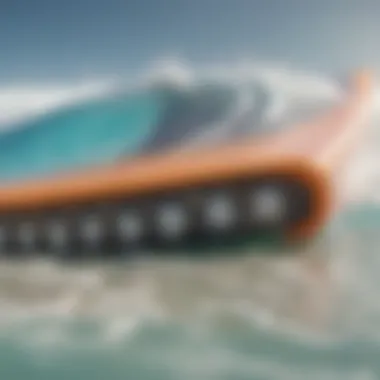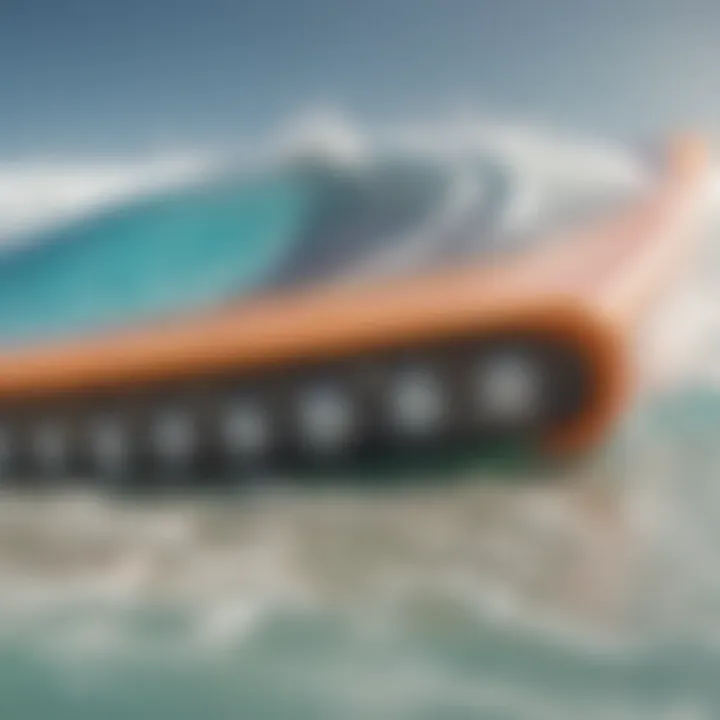Mastering the Surfboard Volume Calculator


Intro
Understanding your surfboard’s volume is like knowing the secret sauce to enhance your time on the waves. Many surfers focus on the shape, color, and brand of their boards, often overlooking a crucial aspect that can greatly affect performance. The surfboard volume calculator is designed to take the guesswork out of selecting the right equipment based on individual preferences and skill levels. Whether you're catching small waves or tackling hefty swells, the right volume can make all the difference.
Before diving headfirst into calculations, it’s important to grasp what volume actually means in the context of surfboards. In simple terms, volume refers to the amount of space inside the board. This measurement directly influences buoyancy, stability, and the overall feel of the board in the water. A well-balanced board tailored to your unique physique lifts you up and gives you more control, which is essential for both beginners and seasoned pros alike.
This article is aimed at equipping you with insights about surfboard volume calculations, which in turn can lead to a deeper connection with your oceanic endeavors. We’ll take a close look at what influences volume calculations, how to adapt your board choice to your skillset, and the role of various surfboarding techniques in making the most out of your equipment. By combining the art and science of surfing, you can elevate your riding experience to new heights.
"Knowing your surfboard’s volume is not just a number; it’s about understanding how to harness the waves in your favor."
Now, let's venture into the realm of surfboarding techniques to better understand how your skills can influence the type of board that’s best for you.
Prolusion to Surfboard Volume
When it comes to surfing, understanding the nuances of your board can make all the difference in your performance. One of the most crucial aspects that often gets overshadowed by flashy designs and brand names is surfboard volume. This section will unravel not only what surfboard volume is but also why it matters so significantly for surfers of all levels.
Surfboard volume refers to the amount of space a board occupies—think of it as a measure of its buoyancy. It’s key to finding the right balance between control and floatation. The volume is not just a number; it’s the foundation of how a board acts under pressure, how it responds to your weight, and ultimately how you feel while catching a wave. Let’s dive deeper into the meaning of this term and explore its importance in surfing.
Definition of Surfboard Volume
Surfboard volume is typically measured in liters and is determined by a board's dimensions: length, width, and thickness. Basically, it tells you how much water the board displaces. A board with a high volume will float more easily, which can be a game changer when you're paddling out or trying to catch waves. Conversely, a lower volume board may offer better maneuverability and control at high speeds but comes with a trade-off in stability and ease of paddling.
Many surfers often overlook this concept, thinking that having a flashy board is all that matters. But just like in any sport, knowing your equipment inside and out is essential. A well-calculated volume can significantly enhance your performance, allowing for a smoother ride and better overall experience.
Importance of Volume in Surfing
Understanding surfboard volume is essential for various reasons:
- Floatation: A board’s volume directly affects its buoyancy, which influences paddling speed and wave catching ability. A board that suits your weight and surfing style can make even the most challenging conditions feel manageable.
- Balance: Riders need the right amount of volume for balanced performance. Too much volume can lead to a sluggish feel, while too little can cause instability, especially in choppy conditions.
- Personalization: Volume helps surfers personalize their experience based on their skill level and body type. Beginners may benefit from higher volume boards for better stability, while advanced surfers can opt for lower volume options that facilitate more dynamic movements.
An essential takeaway is that volume is not just a technical detail; it is integral to a surfer’s relationship with their board. As you venture into the deeper waters of surfboard selection, knowing your ideal volume can lead you to a more satisfying surfing experience.
"The right volume can be the difference between a tricky session and a thrilling ride."
What is a Surfboard Volume Calculator?
A surfboard volume calculator serves as a digital compass for surfers navigating the vast sea of board selection. Fundamentally, it’s a tool that measures the volume of a surfboard by considering its unique dimensions, including length, width, and thickness. But why is this even important? Well, volume plays a pivotal role in determining how a board behaves on the water, influencing stability, buoyancy, and overall performance. For those who find themselves standing at the surf shop, contemplating which board to take home, understanding this calculator can be as crucial as mastering a wave.
Basic Functions of the Calculator
At its core, the surfboard volume calculator performs a few fundamental tasks. Here are the main functions:
- Measurement Input: Surfboards come in various shapes, and each of these can impact performance. The calculator requires the user to input specific measurements: length in inches, width in inches, and thickness in either centimeters or inches. This data collates to yield the total volume.
- Volume Calculation: Based on the provided dimensions, the calculator uses simple mathematical formulas to calculate the board’s volume. More volume generally translates to more floatation.
- Customization Options: Advanced calculators might offer features allowing users to toggle between different shapes or styles. This feature aids surfers who are looking to compare boards across different categories, making the selection process more intuitive.
"Having the right volume can be the difference between gliding smoothly or fighting to keep afloat, especially for less experienced surfers."
How to Access Online Calculators
Accessing a surfboard volume calculator is easier than slipping on a wetsuit. The digital realm offers a plethora of calculators; many of them are free and easily accessible. Here are steps to find and utilize these tools:
- Search Online: A simple Google search with terms like "surfboard volume calculator" will yield various results. Look for reputable websites or forums that specialize in surfing, such as Reddit or surfing blogs.
- Visit Surf Brands’ Sites: Major surf brands often host their calculators. Websites like Channel Islands or Firewire not only showcase their boards but also provide tools built into their platforms for better customization.
- Mobile Apps: For those who prefer convenience on-the-go, several mobile applications that cater to surfing needs include volume calculators. This can make calculations easier, especially when you're down at the beach, looking at potential boards.
Using these online tools ensures that you’re making informed decisions before purchasing a new board, refining your choice to match your unique surfing style and body characteristics better.
Factors Affecting Surfboard Volume Calculations
When it comes to choosing the right surfboard, understanding the variables that play into volume calculations is absolutely essential. Surfboard volume, measured in liters, can have a huge impact on a surfer's experience by influencing paddle power, stability, and maneuverability. The volume is not just a random number; it is linked intimately to the dimensions of the board and the specific needs of the surfer. Let's delve into the key elements that affect surfboard volume computations.
Board Length and Width
Length and width are two fundamental measurements influencing the volume of a surfboard. Longer boards generally possess more volume due to their extended surface area. This additional volume can aid in buoyancy, making them ideal for beginners and larger riders who need that extra stability.
Conversely, a shorter board often implies a reduction in volume, which caters to more advanced surfers looking for maneuverability and performance on the waves. In essence, someone riding a 6'2" shortboard should expect a different volume than a 9' longboard, even if both have similar widths.
Consider the width also; wider boards will naturally displace more water, thus having a higher volume. This makes them sit higher on the water, providing increased floatation, which is crucial for novice surfers. However, a board that is too wide may feel slow and cumbersome when it comes to sharp turns.
"Knowing the balance between length and width is like dancing—find the rhythm that works for you!"
Thickness and Shape Considerations


Thickness is another major factor that cannot be overlooked. Thicker boards offer greater volume but may hinder your ability to duck dive through larger waves. Most surfboards come in a variety of shapes. For instance, fish-style boards, known for their wider tails and flatter rocker profile, can provide distinct performance benefits due to their inherent volume and surface area.
The shape of the board affects how it performs on the water. A board with a rounded nose may excel in small, mushy surf, giving it more volume that helps maintain planing speed. On the other hand, a pointed nose can enhance precision and speed in bigger waves but might sacrifice some of that easy buoyancy.
The idea here is to find a thickness and shape combo that resonates with your riding style. A beginner might opt for a thicker, more stable shape, while seasoned surfers may look for more performance-driven designs that prioritize agility.
Rider’s Weight and Skill Level
Arguably one of the most personalized aspects of volume calculations involves the surfer's weight and skill level. Heavier surfers require boards with increased volume to maintain adequate floatation. This doesn’t mean that all heavier riders should opt for the same volume; individual preferences play a substantial role. Some surfers may prefer a more buoyant board for easier paddling, while others could opt for a more compact volume for enhanced responsiveness.
Skill level also influences volume choice. A beginner will benefit from a more voluminous board that aids in stability and balance, easing the learning curve. As skills develop, a surfer may choose to downsize their volume. This can provide more control and allow for more intricate maneuvers. Experimental surfers often find that their wave riding improves by adjusting their board's volume in line with their growing capabilities.
In summary, weighing these factors gives surfers a clearer picture of how to optimize their equipment for personal satisfaction and performance. Addressing board length and width, thickness and shape, along with the rider’s physicality and skill level, creates a roadmap for selecting the perfect board. Each surfer's journey is different, and understanding these intricacies makes all the difference in carving the right path on the waves.
How to Use a Surfboard Volume Calculator
Using a surfboard volume calculator may feel like a foreign concept to some, but it can be a game-changer in how one approaches selecting their board. This tool is not just for the tech-savvy surfer; it's a practical resource for individuals looking to optimize their experience on the waves. When properly utilized, it helps surfers consider multiple elements of their setup, fostering greater confidence and ensuring they have a board that aligns with their skill level and body dynamics. The benefits are clear: enhanced performance, improved buoyancy, and ultimately a more enjoyable surfing experience.
Inputting Measurements
When diving into the realm of surfboard volume calculation, one of the first steps is inputting accurate measurements. This part is crucial. As the saying goes, "garbage in, garbage out." If the figures you plug in are off, the resulting volume calculation won't do you justice.
To get the most out of your calculator, gather your board's specific dimensions:
- Length: From nose to tail, this determines the initial glide.
- Width: The widest part contributes to stability.
- Thickness: Affects buoyancy.
Additionally, it's important to account for your own statistics:
- Rider's weight: Heavier surfers need more volume for optimal floatation.
- Skill level: Beginners often benefit from a larger volume, while skilled surfers may prefer a more refined board.
Take your time with this step. Many online calculators require measurements in either inches or centimeters, so make sure to convert your data as necessary to avoid confusion. Having everything in one place can simplify the process remarkably.
Interpreting Results
Once the measurements have been inputted, the calculator will spit out numbers that represent the volume of your surfboard in liters. This can be a bit perplexing at first, especially if you're not familiar with what these figures mean in practical terms. As you look at the result, it’s essential to keep a few things in mind:
- Floatation vs. Performance: More volume usually means better floatation, but it can also affect how your board rides. A too-large board can hinder maneuverability, especially for advanced surfers who balance precision with agility.
- Personal Experience: Compare the output with your previous boards. If you're used to a 40-liter board and the calculator suggests something larger, consider why that might be. Is it because you're still building confidence? Or are you looking to progress in tricky conditions?
- Consult with Experts: After inputting your numbers, chatting with an experienced instructor or board shaper can provide additional insights. They can help you evaluate if a specific volume is indeed suitable for your riding style and environment.
Ultimately, understanding how to interpret the calculator's results gives you the edge in making informed decisions when it comes to your surfboard selection. As with all things in life, knowledge is power.
Practical Tips for Choosing the Right Board Volume
Choosing the right board volume is not just about numbers or calculations; it’s about finding the sweet spot that works for you. The volume of a surfboard directly impacts how it rides, providing insights into how it will perform under various conditions. Selecting the appropriate volume can lead to better stability, maneuverability, and ease of paddling, which enhances your overall experience in the water.
Volume Recommendations for Beginners
For those just starting their surfing journey, it's crucial to pick the right board volume to build confidence and skills. Generally, beginners should choose boards that float more, which means a larger volume. Here are some pointers:
- Aim for a Soft Top Board: A soft top board is often ideal for newcomers. They usually have a higher volume and soft edges, which help avoid injuries from a hard landing.
- Suggested Volume Range: As a ballpark, look for boards with a volume that is roughly 35 to 50 liters, depending on your height and weight. More volume means more stability, which can help maintain balance.
- Consider Your Weight: If you weigh 160 pounds, for example, you might benefit from a board volume around 45 liters. Heavier riders will require even more to achieve the desired buoyancy.
- Test Before Committing: Spend some time in a rental before buying. The experience will provide insights into how different volumes affect your rides.
Optimal Volume for Intermediate and Advanced Surfers
As surfers progress, their volume needs shift. Intermediate and advanced surfers often seek boards that allow for increased performance and responsiveness. Here’s how to navigate these adjustments:
- Less Volume for Maneuverability: Experienced surfers often prefer lower volume boards, around 30 to 40 liters, as they are easier to control and spin.
- Tailored to Riding Style: Depending on whether you’re in large waves or small swells, adjust the volume accordingly. A shortboard might work better in powerful waves while a fish or hybrid can be more versatile in smaller conditions.
- Personal Preference Matters: What works for one surfer may not be suitable for another. Advanced riders should experiment with different board shapes and volumes to find the right match.
- Refinement with Experience: Over time, surfers will develop a sense of what volumes best suit their style. Keeping a mental note of what feels right can guide future purchases.
Choosing the right board volume can make the difference between riding like a pro or floundering like a fish out of water.
In summary, understanding volume is key to optimizing your surfing experience. By following the recommendations for different skill levels and staying attuned to personal preferences, surfers can select the ideal board that complements their unique styles, enabling them to ride the waves with confidence.
Common Misconceptions about Surfboard Volume
Understanding the nuances surrounding surfboard volume is essential for any surfer striving to enhance their experience on the waves. Misconceptions can lead to poor choices, resulting in boards that don’t quite meet one’s needs, ultimately hampering performance. This section addresses common misunderstandings related to surfboard volume, clearing the air and setting the record straight. By shedding light on these misconceptions, surfers can make informed decisions and maximize their time in the water.
Volume vs. Floatation
One of the most pervasive myths is that surfboard volume and floatation are synonymous. While they are related, they are not identical concepts. Volume, measured in liters, quantifies the amount of space a surfboard occupies, which impacts how a board floats on water. However, floatation is influenced by a myriad of factors, including the board’s overall shape, thickness, and bottom contours.
Consider a surfboard with high volume but a narrow outline; it may not float as efficiently as a board with slightly lower volume but a wider outline. Thus, a surfer could find themselves in a pickle, selecting a board solely based on volume without considering its floatation characteristics. To make informed choices when buying a new board, it’s critical to understand that while volume contributes to floatation, it is not the be-all and end-all.


Impact of Volume on Performance
When it comes to performance, many surfers believe that higher volume automatically translates إلى better riding capabilities. This notion can be misleading. While a larger volume board can provide more stability, which is invaluable for beginners, it can become a double-edged sword for seasoned surfers.
For instance, a board with too much volume may hinder maneuverability. As performance demands increase, so does the need for precision in board choice. Thus, intermediate and advanced surfers often opt for lower volume boards for more responsive riding.
"It’s all about finding the sweet spot where volume meets performance." – A seasoned surfer offering insight.
The right volume is a delicate balance that varies from one surfer to another, depending on weight, skill level, and style of riding. Consequently, understanding how volume specifically affects your surfing is vital. It’s not a one-size-fits-all scenario; what works like a charm for one might be a complete flop for another.
Finale
Navigating through misconceptions surrounding surfboard volume enables surfers to craft a well-rounded and tailored approach to equipment selection. It’s not just about the numbers on the calculator; it’s about how those numbers translate into real-world riding experiences. Keep these clarifications in mind, and you’ll be well on your way to making smarter, more informed decisions in your quest for the perfect board.
Analyzing Volume Trends in Surfboards
Surfboard volume isn't just a number; it tells a story. When you dive into analyzing volume trends, you're peeling back layers to understand the evolution of surfing equipment and its impact on performance and style. These trends reflect not only the changing demands of surfers but also advancements in technology and design. By examining how volume preferences have shifted over the years, you can appreciate both historical context and future implications for surfboard craftsmanship.
Historical Perspective
Let’s take a trip back in time. In the early days of surfing, boards were often heavy and bulky, made from solid wood or other dense materials. The surfers of that era sought stability more than anything. A thicker, larger board could offer better buoyancy and balance, allowing for easier paddling and catching waves. As surfing gained traction in the mid-20th century, a new wave of experimentation began. Board shapers started to explore various materials and designs.
During the 60s and 70s, shorter boards with less volume made their debut, thanks to the newfound techniques in fiberglass construction. Surfers wanted speed and agility, which led to boards resembling what we see in many surf schools today. This shift in design also reflected the evolving styles and preferences of surfers, who became more daring in their approaches.
Those years marked a notable transition, pointing to an expanded understanding of how board volume relates to performance. Key surfers like Kelly Slater, known for his innovation, began to voice opinions that challenged conventional thinking, leading to varied shapes that are now part of mainstream gear. The overarching trend was clear: volume was no longer just about floatation; it was intricately linked to performance capabilities.
Modern Innovations in Board Design
Fast forward to today, and you’ll see a remarkable transformation in surfboard design. With innovations in materials and manufacturing processes, the modern surfboard is a blend of art and science. Manufacturers now have a plethora of options, ranging from eco-friendly materials to high-tech composites. This advancement has a direct bearing on board volume. For instance, boards can be designed to maintain low volume while maximally optimizing performance.
New tools, like computer-aided design (CAD), enable shapers to predict how slight adjustments in volume and shape can affect ride characteristics. The precision of these techniques allows for boards that are tailored to individual needs, enhancing aspects such as maneuverability and stability.
For example, some brands have started experimenting with buoyancy-adjusting designs. These boards adapt to water conditions and can provide a different volume experience when needed. Surfers are no longer limited to the standard configurations; rather, they can explore boards that perfectly match their size, weight, and skill, creating a customized experience.
This modern ethos has led to a reconsideration of volume trends. Surfers are beginning to embrace the idea that less volume can sometimes mean more performance, especially for seasoned riders looking for speed and control. Such insights only underline the fact that volume, while still pivotal, is just one piece of the puzzle in the quest for an optimal surf experience.
In summary, by analyzing the historical developments and modern innovations in surfboard volume, we can appreciate how far surfing has come. It’s not merely about selecting the right board but understanding how trends influence styles and personal experiences in the water. As surfers venture into the future, adapting their equipment based on informed choices will be paramount to elevating their connection with the surf.
Sustainable Practices in Surfboard Manufacturing
In recent years, the surfing community has begun to pivot its focus towards sustainable practices in surfboard production. This shift is significant, not just for the planet, but also for the surfers themselves who are becoming increasingly aware of the environmental impact of their gear. Sustainable manufacturing processes can make a profound difference in reducing waste and conserving resources, which ultimately translates into more responsible surfing.
Eco-Friendly Materials and Their Impact on Volume
Using eco-friendly materials is one of the most crucial aspects of sustainable surfboard manufacturing. Traditional surfboards often utilize polyurethane foam and fiberglass, which, while providing excellent performance, are not the most environmentally friendly choices. In contrast, alternatives such as epoxy resins and biofoam foams offer similar buoyancy and durability without the heavy carbon footprint associated with their conventional counterparts.
These materials may impact the volume of the board. Many eco-conscious brands are producing boards that not only match the performance characteristics of traditional boards but often have a unique feel due to their different densities and buoyancy profiles. When choosing sustainable materials, surfers find that boards can maintain a high volume while being lighter and more responsive in the water. Consequently, understanding how these materials interact with volume can lead to better choices that suit an individual’s surfing style.
- Benefits of Eco-Friendly Materials:
- Reduced Environmental Impact: Less reliance on harmful chemicals and processes.
- Enhanced Durability: Many sustainable materials prove to be as or even more durable than traditional options.
- Similar Performance: Innovations have led to materials that rival traditional surfboards in performance metrics.
Incorporating eco-friendly materials into the manufacturing process paves the way for a more thoughtful approach to surfboard design, balancing performance and sustainability.
Recycling and Repurposing Surfboards
Recycling and repurposing surfboards bring another layer to sustainable practices within the surfing community. Given that surfboards have a limited lifespan, initiatives to recycle these products can significantly decrease waste. Some companies offer programs to collect old boards, breaking them down and utilizing the materials to craft new boards or other products, such as furniture or art.
This practice not only diverts waste from landfills but also inspires creativity within the community. Surfers can contribute by thoughtfully disposing of their boards rather than simply tossing them aside. Additionally, a growing number of businesses are now focusing on the creative recycling of waste materials resulting from board production.
"Surfing isn't just about riding waves; it's about riding the wave of innovation in sustainability."
Furthermore, engaging in workshops or community events for board repurposing can help foster a stronger sense of connection among surfers. Not only does this help in understanding the lifecycle of surfboards, but it also highlights the potential to give old gear a new lease on life.
In summary, adopting sustainable practices in surfboard manufacturing is more than a trend; it’s a necessary evolution within the surfing community. These practices not only illustrate a commitment to protecting the environment, but they also enrich the surfing experience for individuals while encouraging future generations to ride waves with a conscious mind.
Case Studies: Successful Volume Calculations
Understanding how surfboard volume calculations can impact performance is best seen through real-life examples. Case studies provide valuable insights into how these calculations play a crucial role for surfers of all levels, assisting them in making informed decisions about their gear. Examining these situations helps to identify patterns, preferences, and practical applications of volume calculations, thus revealing their benefits in real-world scenarios.


Beginner to Intermediate Progressions
For surfers at the beginning or intermediate stages, choosing the right surfboard can be daunting. One case study focuses on Sarah, a novice surfer who is breaking into deeper waters.
Sarah started with a shortboard that looked great but proved to be overly challenging for her skill set. After consulting a volume calculator, she learned her board's volume was insufficient for her weight and experience. The calculator recommended a foamier board with more buoyancy. As a result, Sarah transitioned to a longer, wider board—specifically, a funboard that provided more surface area and stability.
This change allowed Sarah to practice with greater ease, catching waves more frequently and gaining confidence. Her progress not only illustrates the importance of volume in a beginner’s experience but highlights how surfboards tailored to individual metrics aid in the learning curve. Now equipped with the right volume, her excitement for the sport has also exponentially increased, showcasing how vital the right board is from the start.
Advanced Surfer Volume Optimization
As surfers gain experience, the considerations shift. This is where advanced surfers like Mark come into play. Mark, an accomplished competitor, was facing some stagnation in his performance. He decided to delve deeper into the science of board volume.
Using an advanced volume calculator, Mark evaluated his existing shortboard, which served him well for years. However, the numbers indicated it might be too dense for his current needs, especially in particular wave conditions. He re-examined his weight, style, and the specific waves he preferred to tackle.
Utilizing these insights, Mark experimented with a hybrid mid-length board that offered a sweet spot of maneuverability and paddle power. This new board had ample volume, allowing him to catch waves easily while also giving him the agility he needed to execute tricks. Since switching, Mark has not only improved his competition standing but has also made a point of discussing how critical volume optimization has been to his technique.
"Realizing the right volume was key to performance breakthroughs for me," Mark stated in a recent surfers’ forum.
These examples underline how recognizing and adapting surfboard volume can lead to significant advancements in skills, whether one is just starting or competing at an elite level.
By drawing insight from these case studies, surfers can better understand not just how to use a volume calculator, but how to apply the results specifically to their journey in surfing.
Future of Surfboard Volume Calculations
The future of surfboard volume calculations holds significant potential, shaping how surfers assess and select their equipment. As the demands of surfers—whether they're beginners riding small waves or veterans tackling double overhead swells—evolve, so must the tools they use. The surfboard volume calculator is not just a simple number-cruncher; it is an integral part of the surfing experience, influencing performance, comfort, and ultimately, enjoyment on the water.
One major element in this future is the growing emphasis on personalization. Every surfer is unique, and the culmination of individual skill levels, body types, and riding styles necessitates a tailored approach. Utilizing advanced algorithms, upcoming calculators could offer customized volume recommendations based on precise inputs reflecting a surfer’s physical and technical profile. This individualization potentially transforms how boards are selected, leading to a more enjoyable ride.
Another aspect is the ongoing integration of technology into surfing gear. As surfboards become more sophisticated and designed with varying shapes and materials, the importance of accurately calculating volume becomes even more critical. It supports the notion that surfing gear should not only keep pace with evolving techniques but also with diverse environmental conditions. Consequently, we can expect future calculators to incorporate real-time data analytics, further refining volume calculations to suit changing weather patterns and water conditions.
Furthermore, addressing ecological concerns is increasingly crucial for surfers today. As the surfing community becomes more aware of environmental issues, sustainable practices in surfboard manufacturing are becoming paramount. Future volume calculations could include assessments of eco-friendly materials, pushing manufacturers to create boards that are not only high-performing but also minimize environmental impact.
"Customizing volumes based on surf conditions and personal style could make your next ride not just better, but transformative."
Technological Advancements
The technological advancements poised to mark the surfboard industry resonate beyond just flashy innovations. They signal a profound shift towards data-driven decision-making in the world of surfing. Enhanced virtual reality (VR) applications allow surfers to visualize their performance metrics in an immersive context, assessing how various volumes impact their rides. This allows for real-time adjustments, promoting skill progression.
Additionally, hardware technology, such as smart sensors embedded in surfboards, can collect performance data. These sensors might record details such as wave height, speed, and rider movements, allowing volume calculators to recommend boards dynamically. Surfers could receive suggestions on what volume adjustments could lead to improved handling or stability based on the latest data from their previous sessions.
Integration of AI and Data Analysis
The integration of AI could revolutionize how surfers interact with their boards, effectively turning traditional surfing gear into intelligent assistants. Imagine an application that assesses weather patterns, wave conditions, and personal performance metrics—all to suggest the optimal surfboard volume for the day. Not just a calculator, but a comprehensive toolset transforming the whole surfing experience.
This evolving landscape where machine learning and data analytics converge means that surfboard volume calculators could become predictive rather than solely reactive tools. Based on historical data from countless surfers, calculators might be able to anticipate what volume adjustments would be beneficial based on similar profiles or conditions.
In summary, the future of surfboard volume calculations is not just about numbers; it’s about evolving the surfing experience into a realm where technology and personal expertise harmonize. This ensures that every surfer, regardless of their journey in the sport, can find enjoyment and mastery at every swell they ride.
The End
In the final analysis, understanding the role of surfboard volume is paramount for any surfer looking to elevate their performance on the waves. This article emphasizes several key topics: the actual definition of surfboard volume, its significance in surfing, and the mechanics behind using a volume calculator. It’s not just about picking a board; it requires a blend of personal preference and technical knowledge.
Benefits of Grasping Surfboard Volume:
- Knowing how volume affects your ride helps in choosing a board that feels right under your feet.
- It maximizes your potential by ensuring you select equipment that's tailored to your skills and body dimensions.
- Understanding this aspect can lead to improved balance, stability, and maneuverability in various conditions.
For both novices and seasoned surfers, this understanding lays the foundation for making informed decisions that enhance not only performance but also enjoyment of the sport. As surfboards evolve with technology and trends, staying informed is crucial for finding that perfect match.
Summary of Key Points
Throughout the article, several pivotal aspects have been highlighted that collectively assist surfers in comprehending the critical nature of surfboard volume.
- Definition and Importance: Knowing what surfboard volume entails helps in understanding how it contributes to the overall surfing experience.
- Volume Calculation Factors: Each decision in board selection hinges on factors like length, width, thickness, and the surfer’s weight.
- Using Calculators Effectively: Practical guidance on utilizing online volume calculators enhances the process of choosing the right board based on data.
This compilation of insights serves to enhance surfers’ awareness about how varying volumes impact the ride and feel, ensuring they aren't left high and dry when it comes to making informed equipment choices.
Final Thoughts on Surfboard Volume Selection
When it comes down to it, surfboard volume isn’t a one-size-fits-all proposition. It's critical to engage in thoughtful consideration about what board volume means for you personally. Factors such as your surfing style, physical characteristics, and the type of waves you typically ride should all influence your selection process.
Consider these points for surfboard volume selection:
- Always take your weight into account—this is a game-changer in determining board floatation and stability.
- Don’t shy away from experimenting with different volumes as your skill set evolves.
- Observe trends in surfboard design and how changes in materials or shapes might affect volume calculations.
Ultimately, a deep comprehension of how surfboard volume contributes to the surfing experience can empower surfers to make choices that not only match their skills but also reflect their personal surfing ethos. Embrace the journey of discovery, and soon you'll find that every wave becomes an opportunity to hone your craft.















